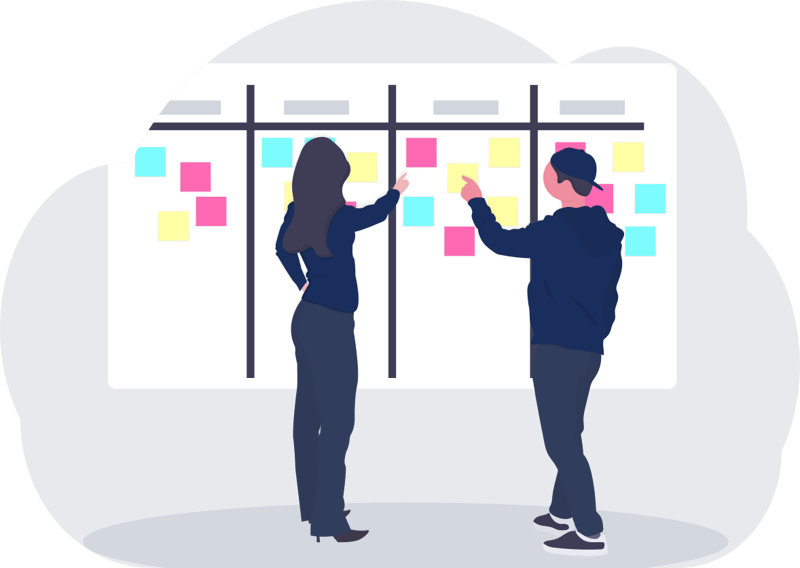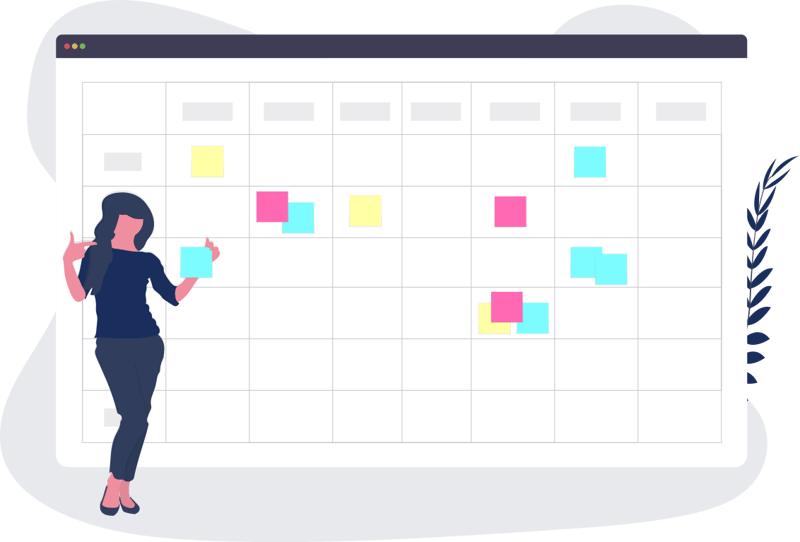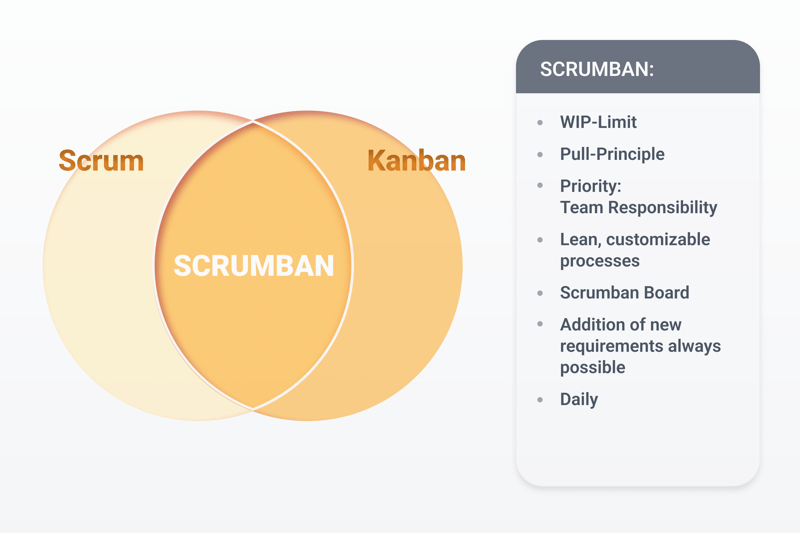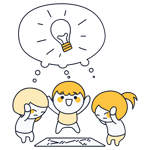Scrumban: Agile Project Management With the Best of Scrum and Kanban
It's hard to have famous parents and Scrumban definitely owes its popularity to its heritage: The relatively new Agile project management framework was created when two well-known and established methods, Scrum and Kanban, were combined. However, is Scrumban greater than the sum of its parts?
Scrumban has significant competition since modern project managers have a growing number of frameworks and methods to choose from for their projects. But, not every framework is equally well-suited for every team. Since conditions and requirements vary, project managers must choose carefully.
In this article, we'll let you know what Scrumban is, and when it makes sense to use it.
What Is Scrumban?
The hybrid method features characteristics of both Scrum and Kanban, however, before we take a closer look at these, we want to introduce its parents.
Scrum
Scrum can trace its origins to software development. The Agile framework is based on the premise that a product is never finished. Instead, new iterations and versions are delivered at the end of every Sprint. This period of time typically lasts no longer than four weeks and sees a certain task, assignment, or project completed.
Scrum Events are precisely specified: There's Sprint Planning, during which the team sets goals in the form of stories. For these, the team pulls tasks from the backlog. The Daily Scrum is a 15-minute meeting held once per day at which the team plots the project's progress.

Scrum is one of the most popular Agile project management methods.
A Review is held at the end of a Sprint, along with a Retrospective. During these, the team informs stakeholders of the Sprint's results and takes time to review and try to find ways to improve their teamwork and efforts.
Roles are also clearly defined: The product owner (PO) is responsible for increasing the product's value and the backlog. The Scrum master overcomes roadblocks as well as arranges and moderates Scrum events.
Kanban
This Agile method is easily recognizable since it's a visualization tool. A Kanban board is used to transparently display progress within a project or undertaking, typically in one of three columns:
Open
In Progress
Done
Toyota developed the method to improve new and existing work and production processes. Tasks and assignments move (as cards) from one column to the next as they're worked on.

Cards, which represent tasks or assignments, move from left to right on the Kanban board as they near completion.
The work-in-progress (WIP) limit is one of Kanban's key features. This specifies an upper limit for the number of assignments that can be "In Progress" at any one time and prevents teams from being overburdened. So long as the WIP limit isn't reached, team members can "pull" new assignments from the backlog to work on.
Users of this framework have a number of different options when it comes to implementation. This is because Kanban doesn't have specific roles or events. Even the columns can be added to at will, however, it's suggested to keep the core three, at a minimum.
Scrumban: The Hybrid
Scrumban is made up of the two methods detailed above.

The hybrid method inherited these characteristics from its "parents":
Scrum aspects
Regular meetings ensure that project processes continually improve, along with a review and retrospective.
Dailys.
The team develops a "definition of done": Everyone agrees about what qualities the finished work or product should have.
Sprint character: The team can freely use any period of time they'd like, however, Sprints typically last two weeks.
Kanban aspects
WIP limits prevent the team from becoming overburdened.
Board on which task cards are visualized.
The team uses the pull principle.
New assignments can be added to the board at any time.
What are Scrumban's characteristics?
Scrumban is not set in stone and offers teams quite a bit of flexibility. As a result, the character of Sprints can develop in a way that is continuous and flow-based. Or, the team can borrow more from either Scrum or Kanban. For example, roles (as in Scrum) can be created if the team thinks that these are necessary.
Apart from that, Scrumban is also characterized by the lack of a team hierarchy. All team members are equal and organize both themselves as well as their team. Deadlines are not an absolute must, however, they allow for product life cycles to be visualized. Teams can set parameters that work most effectively for them.
Scrumban in Practice
As you can see, Scrumban can be easily adjusted and adapted to nearly any situation. Next, we'll let you know about some of the aspects that characterize Scrumban in practice.
Teamwork and Prioritization
As briefly mentioned above, Scrumban does not have any team hierarchy or roles, unless the team decides that they need these. This means that team members work on an equal footing with one another and jointly direct the project's course.
Said differently: The team is jointly responsible for prioritization. This allows them to decide which aspects of the product are the most important.
Scrumban Board
Scrumban's board serves the same purpose as boards do in Scrum and Kanban, namely, to visualize work processes. However, unlike Kanban, there are more than three columns. The "Open" or "To-do" column is often subdivided further into "Product Backlog" and "Sprint Backlog" columns. "In Testing" or "To Test" columns are also popular.
How exactly the board is arranged and which columns it includes depends entirely on the team. Work cards, on which tasks are defined, move across the board and visualize the workflow.
WIP Limits
Once again, the team decides how many cards can be worked on in a single column at any one point in time. The WIP limit isn't just for the "In Progress" column, but can also be extended to that for "Testing". Once the maximum has been reached, team members cannot pull any more cards until a free slot is available.
However, because Scrumban is so flexible, the team can adjust the WIP limit based on experience and greater familiarity with the method.
Pull Principle
Scrumban teams use the pull principle: This means that everyone can pull a task from the backlog and work on it until a certain limit of assignments is reached.
This ensures that the team and its members decide on their workflow and don't have work "pushed" on them from above. It's also faster and more efficient than centrally allocating work. There's no supervisor who needs to check for an open assignment or need for work. The team (and its members) completes work that's unclaimed and maximizes its capacities and capabilities.
Need-Based Planning
The model's flexibility is one of its key advantages, and this is also visible in terms of scheduling. Teams can plan based on their needs and make short-term changes if required. New, high-priority assignments can be added to the board at any time, unlike Scrum. This means that the team can start to work on them quicker than they would be able to with other Agile methods.
But Scrumban isn't only good for the short-term: It's also useful for long-term planning. This is done through a bucket plan, in which resources are organized for specific periods of time, such as for the next 6 or 12 months.
Meetings
In Scrum, the Daily only lasts 15 minutes but serves as the basis for team collaboration. Every member knows exactly how a particular task is progressing, and how resources are allocated.
Other Scrum events are also part of Scrumban, such as:
Review or Demo
Retrospective
Prioritization planning
As with the points above, the team can adjust intervals and events based on their needs.
Scrumban's Advantages and Disadvantages
Scrumban is highly flexible and versatile. This brings quite a few benefits, however, there are some drawbacks as well:
Advantages
Combines the best aspects of Scrum and Kanban.
Organizations are not bound to strict frameworks, but can adjust them to their needs.
Teams are more capable and can react quicker.
The team works on an equal basis, without any fixed roles or hierarchy.
Process and work speed can be increased.
Well-suited for many different types of projects (even long-term ones).
Add new assignments or tasks at any time.
Unlike Scrum, velocity does not need to be measured.
Disadvantages
The lack of a defined leadership role can create management issues.
Project managers have less influence.
Relatively new method; lacks documented case studies which provide insight into common hurdles or challenges.
Teams can fall into a vicious cycle of improvement and betterment that prevents them from making any real progress.
When to Use Scrumban
As with any method, businesses and organizations should ensure that the framework meets their needs and matches their culture. We can particularly recommend it in certain conditions, such as when:
Scrum's implementation has failed or is impractical: This can happen if it was rejected by employees, or the conditions weren't right for it.
Businesses want more agility and leaner project management (Scrumban is more agile than Scrum).
A company needs a transitional period between Scrum and Kanban (or vice versa).
Long-term projects are planned that will have a continuous workflow or product life cycle.
Conclusion
Scrumban offers the best of both worlds in terms of Scrum and Kanban. It allows lean and Agile project management and scores thanks to its structure which provides considerable flexibility and customizability. Because it's so adaptable, the framework is well-suited for a variety of different types of projects, even long-term ones.











